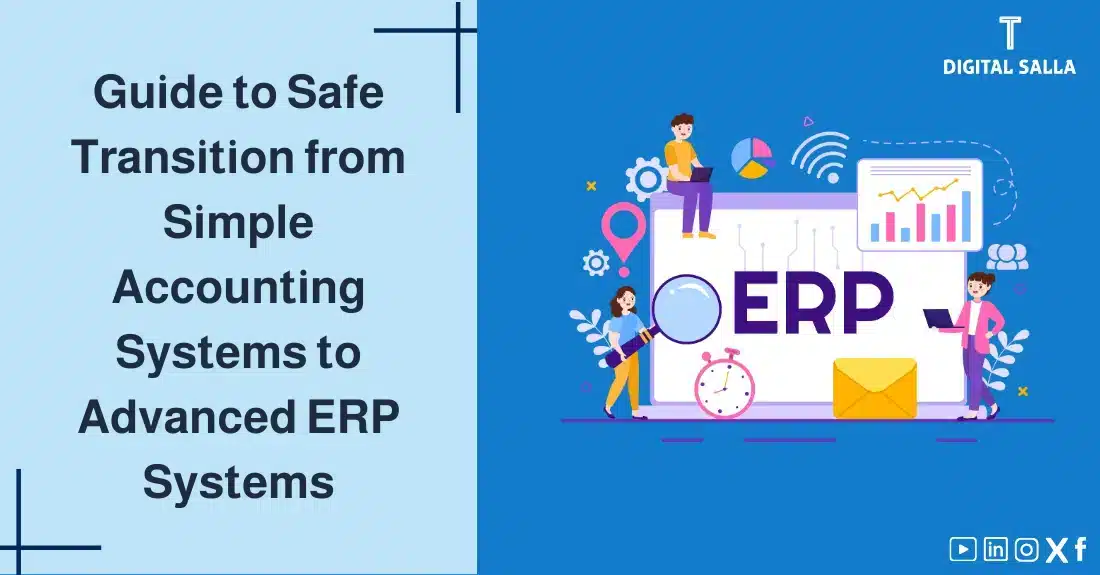Guide to Safe Transition from Simple Accounting Systems to Advanced ERP Systems

As businesses grow and their operations become more complex, the need for more sophisticated accounting and management systems becomes apparent. This is particularly important for companies looking to streamline their financial processes, improve data accuracy, and gain a more holistic view of their operations. This is where Advanced ERP Systems come into play. Migrating from simpler accounting systems to Advanced ERP Systems is a strategic move that offers significant benefits to companies.
It enables them to improve operational efficiency, enhance financial data accuracy, save time and effort, and gain comprehensive insights into employee costs and performance. In this article, we will discuss migrating from basic accounting systems to Advanced ERP Systems, we will identify its benefits, potential challenges, and steps for a smooth transition, with a focus on the importance of careful planning, choosing the right system, and managing change effectively to ensure the success of the transition process.
What are Enterprise Resource Planning (ERP) Systems?
Enterprise Resource Planning (ERP) systems are integrated software systems used to manage all aspects of a business’s operations. These systems unify data and processes across all departments of the company, providing a comprehensive view of the entity’s performance and improving operational efficiency.
Benefits of Transitioning to Advanced ERP Systems:
- Improving Operational Efficiency: Advanced ERP Systems automate many manual tasks, saving time and effort and reducing human errors. These systems help streamline business processes and improve their efficiency.
- Enhancing Accuracy of Financial Data: Advanced ERP Systems ensure the accuracy of financial data by unifying accounting processes and applying standardized accounting rules. These systems also provide tools to verify the accuracy and completeness of data.
- Providing a Holistic View of the Business: Advanced ERP Systems offer a comprehensive view of the entity’s performance by integrating data from all departments into one system. This comprehensive view helps management make more informed decisions.
- Improving the Decision-Making Process: Advanced ERP Systems provide accurate and up-to-date information that helps management make informed decisions about all aspects of the business, such as production, marketing, sales, and finance.
- Enhancing Financial Control: Advanced ERP Systems provide advanced control tools that help prevent fraud and embezzlement and improve compliance with accounting standards.
- Improving Customer Service: Advanced ERP Systems help improve customer service by providing integrated information about customers and their needs. Employees can easily access customer data, enabling them to provide better and more efficient service.
- Increasing Productivity: Advanced ERP Systems increase employee productivity by automating routine tasks and providing easy-to-use tools.
- Supporting Business Growth: Advanced ERP Systems help companies expand and grow by providing an integrated platform for managing all aspects of the business. These systems offer the scalability and flexibility necessary to adapt to changing business needs.
- Improving Inventory Management: Advanced ERP Systems provide advanced tools for inventory management, which helps improve supply chain efficiency and reduce storage costs.
- Enhancing Collaboration Between Departments: Advanced ERP Systems facilitate the process of exchanging information and collaboration between different departments in the entity, improving the efficiency of teamwork.
Potential Challenges When Transitioning to Advanced ERP Systems:
- High Cost: The cost of purchasing, implementing, and maintaining Advanced ERP Systems can be high, especially for small and medium-sized enterprises. The cost includes purchasing software licenses, implementation costs, training costs, and maintenance and support costs.
- Complexity of Implementation: Implementing Advanced ERP Systems can be complex and time-consuming, requiring careful planning and effective change management. It may require significant changes in the company’s business processes.
- Resistance to Change: Some employees may resist the changes that accompany the implementation of a new ERP system, especially if they are used to using old systems. Intensive awareness and training programs may be required to overcome this resistance.
- Need for Training: Using ERP systems requires extensive training for employees to ensure the system is used effectively. The company may need to invest in specialized training programs for its employees.
- Risk of Project Failure: There are risks of an ERP system implementation project failing if it is not managed properly. Project failure can lead to significant financial losses for the company.
- Dependence on the System Vendor: The company relies heavily on the ERP system vendor to operate and maintain the system. A reliable vendor that provides high-quality technical support services must be chosen.
Steps for a Safe Transition from Basic Accounting Systems to Advanced ERP Systems:
- Define Clear Objectives: Clear objectives for transitioning to an Advanced ERP Systems must be defined, such as improving operational efficiency, enhancing financial data accuracy, or improving customer service. These objectives should be measurable and achievable.
- Assess Needs: A comprehensive assessment of the company’s needs for an ERP system must be conducted, including identifying the required functions, the number of users, and the allocated budget. The needs of all departments in the company, such as accounting, sales, purchasing, inventory, and human resources, must be considered.
- Choose the Right System: An ERP system that meets the company’s needs and is compatible with its budget must be selected. Factors such as ease of use, scalability, technical support, and integration with other systems should be considered. To learn more about how to choose the right system, you can read our article on: [Comprehensive Guide to Accounting Software].
- Develop an Implementation Plan: A detailed plan should be developed to implement the ERP system, including the timeline, required resources, and responsibilities. The project should be divided into multiple phases to ensure ease of management and control.
- Manage Change: Employees must be prepared for the changes that will accompany the implementation of the new ERP system through effective communication and providing the necessary training. Any concerns or resistance to change must be addressed effectively.
- Data Migration: Data must be migrated from the old system to the new ERP system carefully and accurately to ensure no data is lost. Data should be cleaned and arranged before migrating it to the new system.
- System Testing: The new ERP system must be thoroughly tested before it goes live to ensure that it works correctly and meets the company’s needs. Multiple tests should be performed, such as integration testing and user acceptance testing.
- User Training: Comprehensive training must be provided to users on how to use the new ERP system. The training should cover all system functions relevant to each user.
- Operation and Support: After the ERP system goes live, ongoing support should be provided to users and any problems they encounter should be addressed. The system’s performance should also be monitored and necessary adjustments made when needed.
- Review and Evaluation: The performance of the ERP system should be reviewed and evaluated periodically to ensure that it is achieving the desired objectives and to make necessary adjustments when needed. The Return on Investment (ROI) from implementing the ERP system should be measured.
Importance of Careful Planning for the Transition Process:
Careful planning is crucial for the success of the transition to an Advanced ERP Systems. The transition plan should include the following:
- Defining the Project Scope: Identifying the departments and processes that will be included in the new ERP system. The project objectives should be clearly defined and measurable.
- Defining the Implementation Timeline: Developing a realistic timeline for implementing the project, specifying the key implementation phases and the deadlines for each phase.
- Defining the Budget: Determining the budget needed to purchase, implement, and maintain the ERP system. The budget should include software purchase costs, implementation costs, training costs, and maintenance and support costs.
- Identifying the Project Team: Forming a specialized team to implement the project, including representatives from various departments. Team members should have the necessary skills and expertise to successfully implement the project.
- Identifying Functional Requirements: Determining the functions and features that the new ERP system should provide. All departments should participate in identifying these requirements.
- Selecting the System Vendor: Choosing a suitable vendor for the ERP system that has a good reputation and extensive experience in implementing similar projects. Vendor proposals should be carefully evaluated and the most suitable offer for the company’s needs should be selected.
- Managing Project Risks: Identifying and assessing the risks related to the ERP system implementation project and developing plans to mitigate these risks. The risk management plan should be reviewed periodically and updated when necessary.
Role of Consultants in the Transition Process:
External consultants can play an important role in the success of the transition to an Advanced ERP Systems, as they can provide:
- Expertise: Consultants have extensive experience in implementing ERP projects and can help companies avoid common mistakes.
- Knowledge of Best Practices: Consultants can provide advice on best practices in designing and implementing ERP systems.
- Technical Support: Consultants can provide technical support to the company during all stages of the transition process.
- Project Management: Consultants can help the company manage the ERP system implementation project effectively.
- Training: Consultants can provide training to employees on how to use the new ERP system.
Integration with Other Systems:
The new ERP system must be able to integrate with other systems used in the company, such as Customer Relationship Management (CRM) systems and Supply Chain Management (SCM) systems. Integration helps improve operational efficiency and provide a comprehensive view of the company’s performance. Integration can also help improve the accuracy of financial data by automatically exchanging data between systems.
Importance of Training on the New System:
Training is an essential element for the success of ERP implementation. The company must provide the necessary training to all users on how to use the new system effectively. The training should cover all system functions relevant to each user and should be delivered in an easy-to-understand manner. Training can help reduce resistance to change from employees and ensure that the system is used correctly.
Impact of the Transition on Financial Statements:
Transitioning to an Advanced ERP Systems may lead to changes in accounting policies and methods of presenting financial information in the financial statements. The company must disclose these changes and their impact on the financial statements in accordance with International Financial Reporting Standards.
Importance of the Chart of Accounts and Cost Centers:
The chart of accounts and cost centers are among the most important components of any accounting system, and they must be carefully designed to ensure the accuracy of financial data and the ease of analysis. The design of the chart of accounts and cost centers must be aligned with the structure of the new ERP system to ensure data integration and ease of reporting. To learn more about how to design a chart of accounts and cost centers, you can read our article on: [Cost Center Chart Design Guide to Match the Organization’s Activity and Information Objectives]
Measuring Return on Investment (ROI) from ERP Systems:
The return on investment from implementing ERP systems can be measured by assessing the financial and non-financial benefits that the company has achieved from implementing the system. Financial benefits include cost savings resulting from automating processes, improving inventory management efficiency, and improving receivables collection. Non-financial benefits include improved accuracy of financial data, enhanced internal control, and improved customer service.
Conclusion:
Transitioning from basic accounting systems to Advanced ERP Systems is an important strategic step that enables companies to improve the efficiency of their operations, enhance the accuracy of their financial data, and support decision-making. This transition requires careful planning and effective change management to ensure the success of the transition process.
By following the appropriate transition steps, consulting with experts when needed, and investing in employee training, companies can maximize the benefits of ERP systems and achieve their financial and administrative goals. Digital transformation is no longer a luxury, but a necessity to keep pace with the rapid developments in the business environment, and investing in ERP systems is a key step towards achieving excellence and success in the digital age.
